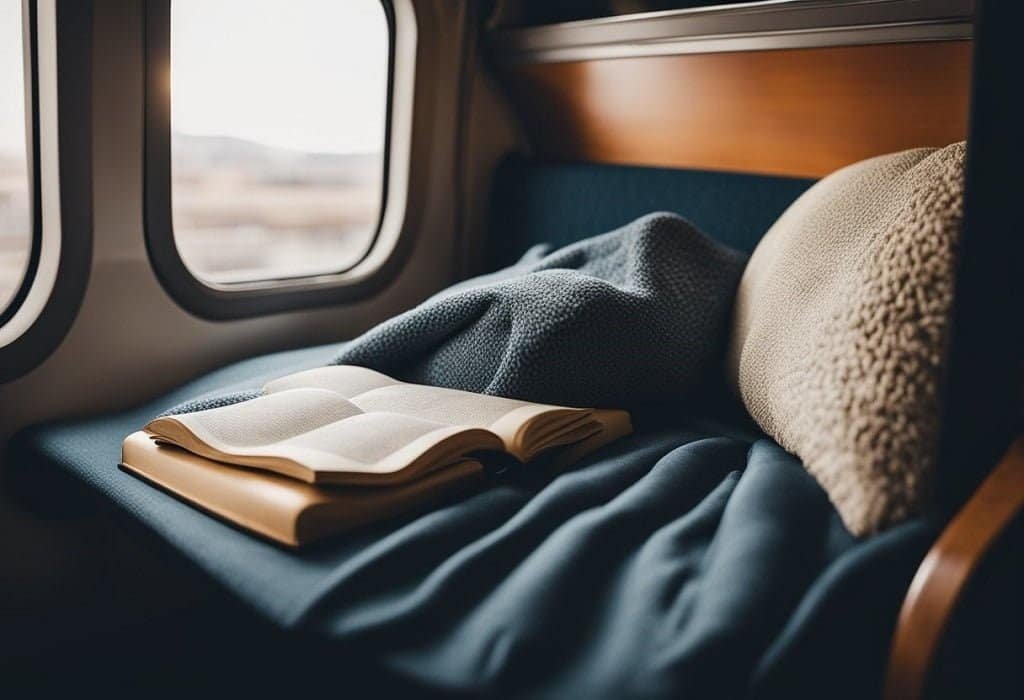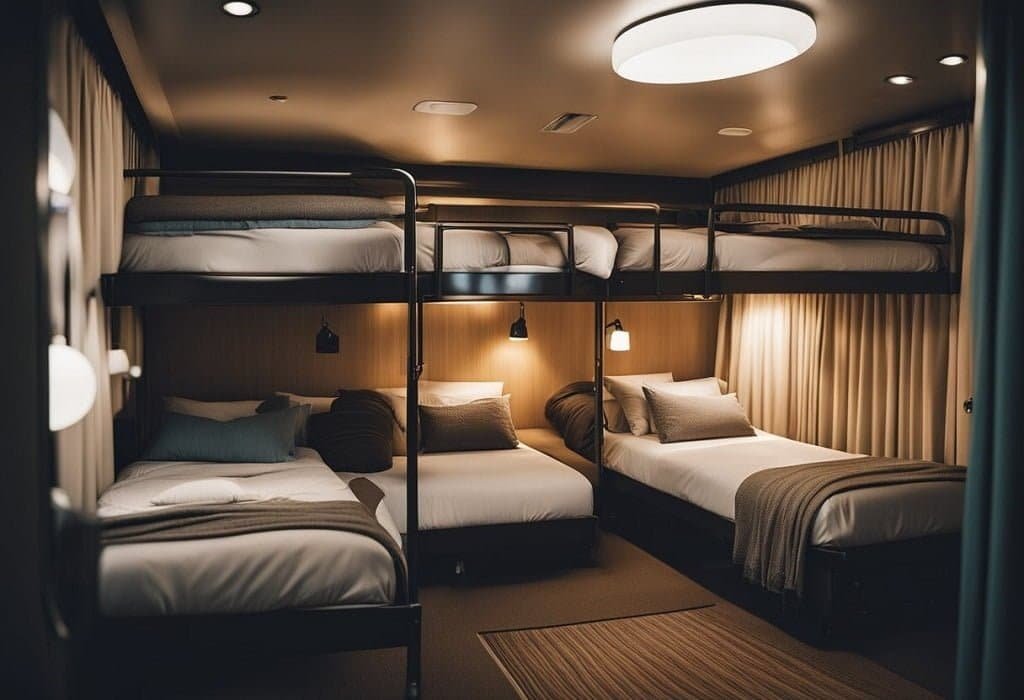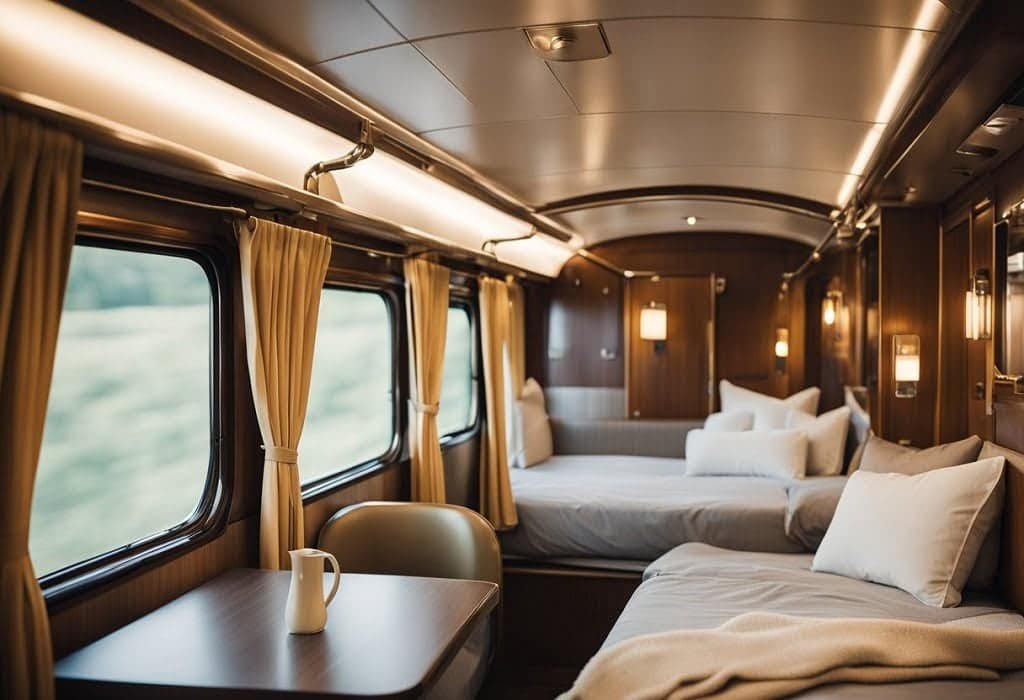Have you ever dreamed of traveling across the country on a train? Watching the landscape roll by, reading a book, or just relaxing as the train chugs along is undoubtedly appealing. But what about sleeping on a train? Where do you sleep? What are the options? And is it comfortable?
In this blog post, I will share the different sleeping places on a train, from private sleeper cabins to shared sleeper cabins and couchettes. I will discuss the costs and amenities of a sleeping place train.
By the end of this post, you’ll have a better understanding of the sleeping options available on trains and be able to make an informed decision about which option is right for you. So if you’re planning a train trip and wondering where to sleep, keep reading!
Is It Safe to Sleep on a Train?
Yes, it is generally safe to sleep on a train. It is vital to take some safety measures to ensure that you have a comfortable and secure journey.
When traveling on a train, make sure to keep your valuables with you at all times. If you sleep in a shared cabin, keep your luggage locked and secure. Also, avoid leaving your cabin door unlocked or open while sleeping.
Being aware of your surroundings and the people around you is also essential. If you feel uncomfortable or unsafe, notify a train attendant or conductor immediately.

What Are the Different Types of Sleeping Places on Trains?
There are several types of sleeping places available on trains, each with its unique features and benefits. Here are 12 types of sleeping places that you may find on a train:
Roomette: A roomette is a small private cabin for one or two people. It features two seats that convert into a bed at night, a small table, and a large window for enjoying the view. Some roomettes also have a private toilet and sink.
Bedroom: A bedroom is a more extensive private cabin for one or two people. It features a sofa and armchair that convert into beds at night, a private toilet, sink, shower, and a large window for enjoying the view.
Suite: A suite is two adjoining bedrooms that can accommodate up to four people. It features all the amenities of a bedroom, including a private toilet, sink, and shower, but with the added benefit of extra space and privacy.
Family Room: A family room is a more extensive private cabin that can accommodate up to four people. It features two bunk beds, a sofa that converts into a bed at night, and a private toilet and sink.
Accessible Bedroom: An accessible bedroom is a private cabin that is designed for passengers with disabilities. It features extra space for maneuvering a wheelchair and a private toilet, sink, and shower.
Superliner Bedroom: A Superliner bedroom is a private cabin available on some Amtrak trains. It features a sofa and armchair that convert into beds at night, as well as a private toilet, sink, and shower.
Superliner Roomette: A Superliner roomette is a tiny, private cabin for one or two persons. It has a massive window for taking in the scenery, two seats that can be turned into beds at night, and a small table.
Viewliner Bedroom: A Viewliner bedroom is a private cabin available on some Amtrak trains. It features a sofa and armchair that convert into beds at night, as well as a private toilet, sink, and shower.
Viewliner Roomette: An individual or couple’s modest, private cabin is called a Viewliner roomette. There’s a tiny table, two seats that can be turned into beds at night, and a big window to take in the scenery.
Couchette: A couchette is a shared cabin with bunk beds or foldable sofa beds. It is standard on most overnight trains.
Luxury Suite: Some trains offer luxurious suite-style cabins with unique amenities, such as a private balcony, a fireplace, or a Jacuzzi.
Open Berth: An open berth is a sleeping car accommodation that is available on some trains. It features a bed in a shared compartment with other passengers.
How to Book a Sleeping Place?

Booking a sleeping place on a train is a straightforward process that can be done online or over the phone. Here are the steps to follow:
- Choose your train and route: Before booking your sleeping accommodations, you need to decide on the train and route you want to take. You can find information about different trains and routes on the official website of the train company.
- Select your sleeping accommodations: Once you have chosen your train and route, you need to select the type of sleeping accommodations you want. There are different types of sleeping accommodations available, such as roomettes, bedrooms, and family rooms. Each type of accommodation offers different amenities and prices.
- Make a reservation: After choosing your sleeping accommodations, you must make a reservation. You can do this online or over the phone. To make a reservation, you must provide your personal information, such as your name, address, and payment information.
- Confirm your reservation: Once you have made your reservation, you will receive a confirmation email or letter. It is essential to review the confirmation to ensure that all the details are correct. If you find any errors, you should contact the train company immediately.
- Pay for your reservation: You must pay before the departure date. You can pay online or over the phone using a credit or debit card. Some train companies also accept other forms of payment, such as PayPal or bank transfer.
Following these simple steps, you can book a comfortable sleeping place on a train and enjoy a relaxing journey.
READ: Over The Counter Flight Anxiety Medication
How to Choose the Right Sleeping Accommodation for Your Trip?
Choosing the suitable sleeping accommodation for your train trip is crucial to ensure a comfortable and enjoyable journey. With various options available, deciding which one to choose can be overwhelming. Here are a few factors to consider when selecting the suitable sleeping accommodation for your train trip.
1. Type of Train
Different types of trains offer different types of sleeping accommodations. Some trains have only basic sleeping options like reclining seats, while others have private cabins with beds and en-suite bathrooms. Before booking your ticket, research the train you will be traveling on and the sleeping options available.
2. Length of Journey
The length of your journey is an important factor to consider when selecting your sleeping accommodation. For a short journey, a seat that reclines may be sufficient. A private cabin with a bed and en-suite bathroom will provide more comfort and privacy for a long journey.
3. Number of Passengers
Consider the number of passengers traveling with you. If you are traveling alone, a roomette or a single cabin may be suitable. A family cabin or a suite may be more appropriate if you are traveling with a group.
4. Budget
Sleeping accommodations on trains can vary significantly in price. Consider your budget when selecting your sleeping accommodation. If you are on a tight budget, a reclined seat or a shared cabin may be a more affordable option. However, a private cabin or suite will provide more luxury and comfort if you are willing to spend more.
5. Personal Preferences
Lastly, consider your personal preferences when selecting your sleeping accommodation. Do you prefer privacy or socializing? Do you need a private bathroom, or are shared facilities acceptable? Answering these questions will help you choose a suitable sleeping accommodation.
Considering these factors, you can choose the suitable sleeping accommodation for your train trip, ensuring a comfortable and enjoyable journey.
Sleeping Place Design and Layout in Train
The shape and arrangement of the sleeping compartment are crucial elements that determine how comfortable or uncomfortable you are when sleeping on a train. Depending on the kind of train and the distance traveled, there are differences in where people sleep on it.
Most trains offer a range of sleeping accommodations, from private sleeper cabins for those seeking luxury and privacy to shared sleeper cabins and couchettes for travelers on a budget or who enjoy socializing. Additionally, sleeping cars with seats provide a more economical option for shorter journeys.
The sleeping place on a train is designed to maximize space and comfort. The sleeping cabins are usually compact but well-designed to make the most of the limited space available. The cabins feature bunk beds, which can be folded away to create a seating area during the day. The beds usually have comfortable mattresses, pillows, and blankets to ensure a good night’s sleep.
Security and privacy are further features included in the layout of the sleeping area aboard a train. Although shared cabins and couchettes have screens or drapes to offer some privacy, private cabins often have a lockable door. Additionally, power outlets, luggage storage, and reading lights are provided in the cabins.
READ: A Stress-Free Stay in the Heart of Melbourne
Amenities and Facilities in Sleeping Place
You may anticipate having access to various conveniences and services when you reserve a sleeping space on a train, making your trip effortless and pleasant. The following are some of the conveniences and amenities that a train sleeping compartment should offer:
- Beds: Depending on the type of sleeping accommodation you book, you may have access to various bed options, including bunk beds, fold-down beds, and more. All beds come with freshly laundered linens, pillows, and blankets to ensure a comfortable night’s sleep.
- Restrooms: Most sleeping accommodations come with access to a private restroom, so you don’t have to worry about sharing facilities with other passengers. The restrooms typically have a sink, toilet, and shower so you can freshen up during your journey.
- Meals: Depending on the length of your journey, you may have access to complimentary meals and snacks. Some trains offer dining cars where you can enjoy a full meal, while others offer in-room dining options.
- Storage: One of the most significant advantages of traveling by train is the storage space available. Most sleeping accommodations come with storage space for your luggage, so you don’t have to worry about always.
- Electrical Outlets: Most sleeping accommodations have electrical outlets so that you can charge your devices during your journey.
- Wi-Fi: Some trains offer Wi-Fi service so that you can stay connected during your journey. However, the quality of the Wi-Fi service can vary depending on the train and the route.
- Climate Control: Sleeping accommodations typically come equipped with climate control systems so that you can adjust the temperature to your liking.
What Safety Measures Are in Place for Sleeping Accommodations?
Firstly, most trains have a conductor responsible for all passengers’ safety. They will conduct regular checks throughout the train to ensure everything is in order. If you have any concerns or questions, don’t hesitate to approach them.
Secondly, most sleeping accommodations on trains come with a locking door. This ensures that you and your belongings are safe while you sleep. You should always keep your door locked inside your room and when you leave it.
Thirdly, some trains have security personnel who patrol the train and ensure that all passengers are safe. If you have any concerns about your safety, you can approach them for assistance.
Finally, it’s always a good idea to always keep your valuables with you. Don’t leave them unattended in your room or any common areas. You can use a money belt or a miniature lockable bag to keep your valuables safe and secure.
By following these safety measures, you can enjoy a peaceful and secure journey while sleeping on a train.
READ: Why Lake Arenal is Such a Popular Destination for Vacationers?
What Are the Costs Associated with Train Sleeping Accommodations?
The cost of train sleeping accommodations can vary depending on several factors, including the type of accommodation you choose, the length of your trip, and the time of year you are traveling.
Generally, private rooms are the most expensive option, followed by shared sleeper cabins and couchettes. Sleeping cars with seats provide a more economical option for shorter journeys.
On Amtrak, private rooms can range from approximately $300 to $1,000 or more per night, depending on the route and time of year. Shared sleeper cabins and couchettes typically cost less, ranging from approximately $100 to $300 per night.
It’s important to note that the cost of train sleeping accommodations typically includes more than just a place to sleep. Depending on the accommodation type you choose, you may also have access to additional amenities such as meals, drinks, and shower facilities.
These amenities can vary depending on the route and the type of accommodation you choose, so be sure to check with your train operator for more information.
How to Prepare for Your Overnight Train Journey?

Preparing for an overnight train journey is crucial to ensure a comfortable and stress-free experience. Here are some tips to help you prepare for your upcoming journey:
- Pack Light: As trains have limited space, it’s important to pack only essentials. Pack a small bag with necessities such as toiletries, comfortable clothing, and a travel pillow. Check with the train operator beforehand for luggage restrictions.
- Book Your Accommodation: Book your sleeping accommodation in advance to ensure availability. Sleeping options vary from seat accommodations to private cabins with various amenities.
- Dress Comfortably: Wear comfortable clothing and shoes to ensure a good night’s sleep. Layers are recommended as temperatures can fluctuate on the train.
- Pack Snacks: While most trains offer a dining car, it’s always a good idea to pack some snacks if you get hungry during the journey.
- Arrive Early: Arrive at the station early to avoid any last-minute stress. This will also give you time to familiarize yourself with the train and its amenities.
READ: Ultimate Guide to Truck Bed Camping Adventures
How to Sleep on a Train?
Sleeping on a train can be a unique and exciting experience. It can also be challenging, especially if you’re not used to sleeping in a moving vehicle. Here are some tips to help you get a good night’s sleep on a train:
1. Choose the Right Sleeping Accommodation
The type of sleeping accommodation you choose can greatly affect the quality of your sleep. Private sleeper cabins are the most comfortable and private option but tend to be more expensive. If you’re on a budget, a coach seat or a roomette is a more affordable option. Make sure to choose a seat or cabin away from the noise and vibration of the train.
2. Bring Your Comforts
Trains can get cold at night, so bringing your own blanket or sleeping bag is a good idea. Additionally, bring a pillow or neck support to make yourself more comfortable. Earplugs and an eye mask can also help block out noise and light, making it easier to fall asleep.
3. Stick to Your Sleep Routine
Try to stick to your regular sleep routine as much as possible. If you usually go to bed at 10 pm, stick to that schedule even if you’re on a train. This will help your body adjust to the new environment and make it easier to fall asleep.
4. Avoid Stimulants
Avoid caffeine and alcohol before bed, as they can disrupt your sleep. Instead, drink herbal tea or warm milk to help you relax. You can also take a warm shower or bath before bed to help you wind down.
5. Safety First
Make sure to lock your cabin or secure your belongings if you sleep in a public area. Keep your valuables close to you and avoid sleeping with headphones on, as you may not hear essential announcements or alerts.
READ: 100 Mile Wilderness Adventure
Frequently Asked Questions:
What are the different types of sleeping accommodations available on trains?
Various types of sleeping accommodations are available on trains, ranging from private sleeper cabins to shared compartments. Some popular options include roomettes, bedrooms, and accessible bedrooms.
What is the name of the bed on a train?
The bed on a train is commonly referred to as a berth.
Are the beds in sleeper trains comfortable?
Yes, the beds in sleeper trains are designed to be comfortable and provide a good night’s sleep. However, the comfort level may vary depending on the type of accommodation you choose.
How do you book a sleeping berth on a train?
You can book a sleeping berth on a train through the train company’s website or by calling their customer service hotline. It is recommended to book in advance, as sleeping accommodations tend to sell out quickly.
What amenities are provided in a train’s sleeping compartment?
The amenities provided in a train’s sleeping compartment may vary depending on the accommodation type. However, most sleeping compartments have a comfortable bed, storage space for your belongings, and access to a restroom and shower.
Where do you sleep on a train crossword?
You sleep on a train in a sleeping compartment or berth.
Are there private rooms for sleeping on trains?
Yes, there are private rooms available for sleeping on trains. These private sleeper cabins typically come with a comfortable bed, storage space for your belongings, and even a private bathroom in some cases.
How do you sleep on a sleeper train?
To sleep on a sleeper train, it is recommended to wear comfortable clothing and bring along a travel pillow and blanket. Also, try to avoid consuming too much caffeine or alcohol before bedtime.
Do you get a room to sleep on long train rides?
Yes, on long train rides, you can book a private sleeper cabin or berth.
What should one expect from overnight train travel?
One should expect a unique and memorable experience when traveling overnight on a train. It can be a comfortable and convenient way to travel long distances, with the added benefit of waking up in a new destination.
It is crucial to remember that train travel may not be for everyone and can be affected by factors such as noise, motion sickness, and varying levels of comfort depending on the type of accommodation chosen.
Conclusion
Sleeping on a train can be a unique and enjoyable experience for those looking for adventure. Whether you opt for a private or shared sleeper cabin, there are different types of sleeping accommodations available on a train that cater to different budgets and preferences. Additionally, sleeping cars with seats provide a more economical option for shorter journeys.
I hope this article has provided valuable information on sleeping on a train. It is important to remember to pack the essentials such as a travel pillow, earplugs, and an eye mask to ensure a comfortable and restful sleep.
Don’t forget to reiterate the importance of being safe and secure on a train, especially when traveling alone.















